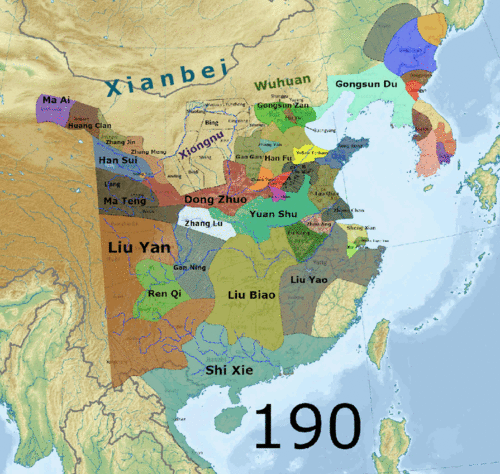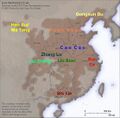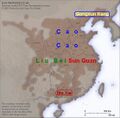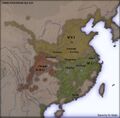Short description: Timeline about the Wei, Wu, and Shu states

Timeline of territorial changes during the Three Kingdoms period.
This is a timeline of the Three Kingdoms period (220–280) of Chinese history. In a strict academic sense, the Three Kingdoms period refers to the interval between the founding of the state of Cao Wei (220–266) in 220 and the conquest of the state of Eastern Wu (229–280) by the Western Jin dynasty (265–316) in 280. However, many Chinese historians and laymen extend the starting point of this period back to the Yellow Turban Rebellion that took place in 184 during the late Eastern Han Dynasty (25–220).
180s
| Year |
Date |
Event
|
| 184 |
spring |
Yellow Turban Rebellion: The Yellow Turbans ravage the north and east and are defeated
|
| winter |
Liang Province rebellion: A rebellion occurs in Liang province (Liangzhou; 涼州; roughly present-day Wuwei, Gansu)
|
| 185 |
|
The imperial palace is damaged by fire and special taxes are levied for rebuilding
|
| 188 |
|
Governors are appointed to unify provincial administrations
|
| 189 |
summer |
Emperor Ling of Han dies; Empress He and her brother He Jin enthrone Liu Bian and establish a regency government
|
| winter |
The Ten Eunuchs kill He Jin and are themselves massacred by Yuan Shao; Dong Zhuo takes control of Luoyang and deposes Liu Bian in favor of his half-brother Liu Xie, Emperor Xian of Han
|
| 189 |
|
Campaign against Dong Zhuo: An anti-Dong Zhuo alliance forms in the east, led by Yuan Shao
|
190s
| Year |
Date |
Event
|
| 190 |
|
Dong Zhuo burns Luoyang, loots the imperials tombs, and relocates to Chang'an
|
|
Battle of Xingyang: Dong Zhuo defeated Cao Cao at Xingyang, Henan
|
|
The Coalition breaks up and local officials set themselves up as warlords
|
| 191 |
|
Battle of Yangcheng: Battle between Yuan Shao and Yuan Shu
|
|
Battle of Xiangyang: Sun Jian dies.
|
|
Zhang Lu sets up a theocracy in Hanzhong.
|
| 192 |
|
Battle of Chang'an: Wang Yun and Lü Bu kill Dong Zhuo and Wang Yun himself is killed by Dong Zhuo's officers Li Jue and Guo Si
|
|
|
The Han dynasty scholar, Cai Yong dies.
|
| 193 |
|
Cao Cao's invasion of Xu Province: Liu Bei first territory as a result of Cao Cao's campaign.
|
| 194 |
|
Battle of Yan Province: Cao Cao takes over Yan Province.
|
| 195 |
|
Emperor Xian of Han escapes from Chang'an
|
|
Sun Ce sets up south of the Changjiang, Sun Ce's conquests in Jiangdong begin.
|
| 196 |
|
Emperor Xian of Han relocates to Xuchang under Cao Cao's control
|
| 197 |
|
Campaign against Yuan Shu: Yuan Shu takes the imperial title but is driven south by Cao Cao
|
|
War between Cao Cao and Zhang Xiu begin.
|
| 199 |
|
Battle of Xiapi: Cao Cao and Liu Bei defeated Lu Bu.
|
|
Battle of Yijing: Yuan Shao eliminates Gongsun Zan in You Province.
|
|
Yuan Shu dies
|
200s
| Year |
Date |
Event
|
| 200 |
|
Battle of Guandu: Yuan Shao is defeated by Cao Cao northeast of modern Zhongmou, Henan
|
|
Sun Ce dies and is succeeded by his brother Sun Quan
|
|
Zheng Xuan dies
|
| 202 |
|
Yuan Shao dies and is succeeded by his younger son Yuan Shang
|
|
Battle of Bowang: Liu Bei defeats Cao Cao at Bowang (near present-day Fancheng District, Hubei)
|
| 203 |
|
Cao Cao's campaigns to unify northern China begin
|
|
Battle of Xiakou: Battle between the warlords Sun Quan and Liu Biao
|
| 207 |
|
Battle of White Wolf Mountain: Cao Cao defeats Yuan Shang and the Wuhuan, Cao Cao unites northern China
|
| 208 |
|
Battle of Jiangxia: Sun Quan defeats Liu Biao and beheads Huang Zu
|
|
Zhuge Liang advises Liu Bei, Liu Biao dies, Cao Cao takes over Jing Province.
|
|
Battle of Changban: Zhao Yun rescues Liu Shan, Liu Bei escapes to Xiakou.
|
|
Battle of Red Cliffs: Cao Cao is defeated on Changjiang, west of modern Jiangxia, Hubei, by Sun Quan and Liu Bei
|
210s
| Year |
Date |
Event
|
| 210 |
|
Liu Bei occupies the south of Jing Province
|
| 211 |
|
Battle of Tong Pass: Cao Cao defeats Ma Chao and Han Sui and starts campaigning in northwestern China
|
|
Liu Bei's takeover of Yi Province: Liu Zhang invites Liu Bei to Yi Province (covering present-day Sichuan and Chongqing)
|
| 214 |
|
Liu Bei's takeover of Yi Province: Liu Bei takes control of Yi Province from Liu Zhang
|
| 215 |
|
Battle of Yangping: Zhang Lu surrenders Hanzhong to Cao Cao
|
| 216 |
|
Cao Cao declares himself King of Wei
|
| 219 |
spring |
Battle of Mount Dingjun: Liu Bei defeats and slays Cao Cao's general Xiahou Yuan and takes Hanzhong
|
| autumn |
Liu Bei becomes King of Hanzhong
|
| Battle of Fancheng: Liu Bei's general Guan Yu attacks north in Jing Province
|
| winter |
Lü Meng's invasion of Jing Province: Sun Quan's general Lü Meng attacks Guan Yu and seizes the south of Jing Province
|
220s
| Year |
Date |
Event
|
| 220 |
|
Guan Yu is executed by Sun Quan.
|
| spring |
Cao Cao dies at Luoyang and is succeeded by his son Cao Pi.
|
|
The Nine-rank system is implemented.
|
| winter |
Cao Pi forces Emperor Xian of Han to abdicate and declares himself Emperor of the Wei dynasty; so ends the Han dynasty.
|
| 221 |
|
Liu Bei declares himself emperor of Han.
|
| 222 |
|
Battle of Xiaoting: Liu Bei is defeated by Sun Quan's general Lu Xun.
|
|
|
Cao Pi's invasions of Eastern Wu: Sun Quan declares independence from Cao Wei; Cao Pi invades Eastern Wu.
|
| 223
|
|
Cao Pi's invasions of Eastern Wu: Sun Quan's forces repel Cao Wei.
|
|
Liu Bei dies and is succeeded by Liu Shan.
|
| 225
|
|
Incident at Guangling: Cao Pi attempts to invade Sun Quan's territory but later withdraws without fighting.
|
|
Zhuge Liang's Southern Campaign: Zhuge Liang conquers Nanzhong.
|
| 226 |
|
Cao Pi dies and is succeeded by Cao Rui.
|
|
|
The Jiaozhou warlord, Shi Xie dies; Sun Quan establishes Guangzhou from parts of Jiaozhou.
|
| 227
|
|
Sun Quan quells Shi Hui's rebellion and seizes Jiaozhou; Sun Quan abolishes Guangzhou.
|
|
|
Zhuge Liang presents the Chu Shi Biao to Liu Shan.
|
| 228
|
|
Xincheng Rebellion: Sima Yi quells Meng Da's rebellion.
|
|
Zhuge Liang's Northern Expeditions: Zhuge Liang's first northern expedition against Cao Wei; Ma Su is defeated by Zhang He.
|
|
|
Battle of Shiting: Lu Xun defeats Cao Wei forces led by Cao Xiu.
|
| 229
|
|
Zhuge Liang's Northern Expeditions: Zhuge Liang's second northern expedition. He is forced to retreat due to arrival of Cao Wei reinforcements.
|
|
Sun Quan proclaims himself "Emperor of Wu" in Jianye (Nanjing); Wu enters an alliance with Shu Han.
|
|
|
Zhuge Liang's Northern Expeditions: Zhuge Liang captures Wudu (武都; near present-day Cheng County, Gansu) and Yinping (陰平; present-day Wen County, Gansu) on his third northern expedition.
|
230s
| Year |
Date |
Event
|
| 230 |
|
Eastern Wu expedition troops land on an island known as Yizhou (suspected to be Taiwan) where most of them die but manage to bring back "several thousand" natives back to China.
|
|
|
Ziwu Campaign: Cao Wei forces led by Cao Zhen invade Shu Han but later retreated.
|
| 231
|
|
Zhuge Liang invents the wooden ox.
|
|
Zhuge Liang's Northern Expeditions: Zhuge Liang's fourth northern expedition. He is forced to withdraw after provisions are exhausted, but managed to kill Zhang He during his retreat.
|
|
|
Battle of Hefei: Sun Quan is repelled by Man Chong; Wang Ling is ambushed by Eastern Wu forces.
|
| 232 |
|
The Cao Wei poet, Cao Zhi dies.
|
| 233 |
|
Sun Quan sends an envoy to Gongsun Yuan in the northeast, but the envoy is killed and brought to Cao Wei
|
|
|
Battle of Hefei: Sun Quan is repelled by Man Chong.
|
| 234
|
|
Emperor Xian of Han dies.
|
|
Battle of Wuzhang Plains: Zhuge Liang dies on his fifth and last northern expedition against Cao Wei; Jiang Wan succeeds Zhuge Liang.
|
|
|
Battle of Hefei: Sun Quan commands his last attack on Hefei but is repelled by Man Chong.
|
|
|
Zhuge Ke campaigns against the Shanyue people of Danyang Commandery.
|
| 235
|
|
Cao Wei assassinates the Xianbei chieftain, Kebineng.
|
|
|
The Cao Wei mechanical engineer, Ma Jun invents the south-pointing chariot.
|
| 237 |
|
Gongsun Yuan declares himself King of Yan.
|
|
|
Zhuge Ke completes his subjugation of the Shanyue.
|
| 238
|
|
Cao Wei receives envoys from Himiko of Yamatai.
|
|
Sima Yi's Liaodong campaign: Sima Yi kills Gongsun Yuan and annexes his territory.
|
| 239 |
|
Cao Rui dies and is succeeded by Cao Fang but real power is wielded by the co-regents Sima Yi and Cao Shuang.
|
240s
| Year |
Date |
Event
|
| 240
|
|
Beginning of the Zhengshi reign era (240–249) in Cao Wei; philosophical movements such as Xuanxue and Qingtan as well as the Seven Sages of the Bamboo Grove emerge in Wei during the era.
|
|
|
Jiang Wei's Northern Expeditions: Jiang Wei's first northern expedition against Cao Wei.
|
| 241
|
|
Battle of Quebei and Fancheng: Eastern Wu attacks Cao Wei in Yangzhou and Jingzhou but later withdraws.
|
|
|
Sun Quan's heir apparent, Sun Deng, dies.
|
| 242
|
|
Sun He becomes Crown Prince of Eastern Wu; Sun He and Sun Ba compete to become Sun Quan's heir apparent, splitting the Wu court into two factions.
|
|
|
Goguryeo–Wei War: Goguryeo raids Cao Wei at Xi'anping (西安平; near present-day Dandong, Liaoning).
|
| 244
|
|
Battle of Xingshi: Cao Wei forces led by Cao Shuang are repelled by Shu Han.
|
|
|
Goguryeo–Wei War: Cao Wei general Guanqiu Jian defeats Goguryeo, taking Gungnae.[6]
|
| 245 |
|
Goguryeo–Wei War: Guanqiu Jian sends his armies to pursue Dongcheon of Goguryeo and subjugate Eastern Ye.
|
|
|
The Eastern Wu Imperial Chancellor, Lu Xun dies.
|
| 246
|
|
Baekje attacks Cao Wei forces at Lelang and Daifang commanderies but later sues for peace.
|
|
|
Jiang Wan and Dong Yun dies; Fei Yi and Chen Zhi succeeds Jiang Wan and Dong Yun respectively.
|
| 247
|
|
Jiang Wei's Northern Expeditions: Jiang Wei's second northern expedition.
|
| 248
|
|
Jiang Wei's Northern Expeditions: Jiang Wei's third northern expedition.
|
|
|
Lady Triệu leads Viet rebels in Jiaozhou but is defeated by Eastern Wu.
|
| 249 |
|
Incident at the Gaoping Tombs: Sima Yi kills Cao Shuang and He Yan, taking over the Cao Wei government.
|
|
The Cao Wei philosopher, Wang Bi dies.
|
|
|
Jiang Wei's Northern Expeditions: Jiang Wei's fourth northern expedition.
|
250s
| Year |
Date |
Event
|
| 250
|
|
Jiang Wei's Northern Expeditions: Jiang Wei's fifth northern expedition.
|
|
|
Sun Quan exiles Sun He and kills Sun Ba; Sun Liang is installed as Crown Prince.
|
| 251
|
|
Three Rebellions in Shouchun: Sima Yi quells Wang Ling's Rebellion.
|
|
Sima Yi dies and his son Sima Shi succeeds him.
|
| 252 |
|
Sima Shi gains the title of "Great General".
|
|
Sun Quan dies and is succeeded by Sun Liang; Zhuge Ke assumes regency.
|
| 253
|
|
Battle of Dongxing: Zhuge Ke defeats Cao Wei forces at Dongxing
|
|
|
Fei Yi is assassinated; Jiang Wei succeeds Fei Yi.
|
|
|
Battle of Hefei: Eastern Wu forces led by Zhuge Ke are repelled by Cao Wei.
|
|
|
Jiang Wei's Northern Expeditions: Jiang Wei's sixth northern expedition.
|
|
Sun Jun and Sun Chen kill Zhuge Ke; Sun Jun assumes regency.
|
| 254
|
|
Jiang Wei's Northern Expeditions: Jiang Wei captures Didao (狄道; around present-day Lintao County, Gansu), Heguan (河關; in the vicinity of present-day Dingxi, Gansu) and Lintao on his seventh northern expedition.
|
|
Sima Shi deposes Cao Fang and replaces him with Cao Mao
|
| 255
|
|
Three Rebellions in Shouchun: Sima Shi quells Guanqiu Jian and Wen Qin's Rebellion.
|
|
Sima Shi dies and his brother Sima Zhao takes over.
|
|
|
Battle of Didao: Jiang Wei is defeated by Cao Wei forces in his eight northern expedition; Shu Han loses territorial gains from Jiang Wei's seventh expedition.
|
| 256
|
|
Jiang Wei's Northern Expeditions: Jiang Wei's ninth northern expedition.
|
|
Sun Jun dies; Sun Chen assumes regency.
|
|
The Cao Wei scholar, Wang Su dies.
|
| 257
|
|
Three Rebellions in Shouchun: The Cao Wei general, Zhuge Dan rebels in Shouchun.
|
|
|
Jiang Wei's Northern Expeditions: Jiang Wei's tenth northern expedition.
|
| 258
|
|
Three Rebellions in Shouchun: Sima Zhao quells Zhuge Dan's Rebellion.
|
|
Sun Liang is deposed by Sun Chen and Sun Xiu succeeds him.
|
|
|
Chen Zhi dies; Chen Zhi's ally, the eunuch, Huang Hao begins to dominate the Shu Han court.
|
| 259
|
|
Sun Xiu kills Sun Chen.
|
|
Goguryeo–Wei War: Cao Wei forces are defeated by Goguryeo at Yangmaenggok.
|
260s
| Year |
Date |
Event
|
| 260 |
|
Sima Zhao’s Regicide: Sima Zhao kills Cao Mao and replaces him with Cao Huan.
|
|
|
Sun Liang dies.
|
| 261
|
|
The Tuoba-Xianbei chieftain, Tuoba Liwei submits to Cao Wei.
|
| 262
|
|
Jiang Wei's Northern Expeditions: Jiang Wei launches his eleventh and final northern expedition.
|
|
Sima Zhao kills Ji Kang, one of the Seven Sages of the Bamboo Grove.
|
| 263
|
|
Jiao Province Campaign: Viet people in Jiaozhou (Northern Vietnam) under Lã Hưng revolted against Eastern Wu. Cao Wei (later the Western Jin) sends armies to aid the rebels.
|
|
Conquest of Shu by Wei: Liu Shan surrenders to Sima Zhao; so ends Shu Han.
|
| 264
|
|
Cao Wei establishes Liangzhou (梁州).
|
|
|
Zhong Hui's Rebellion: Zhong Hui and Jiang Wei rebel in Chengdu but are killed by mutineers.
|
|
|
Siege of Yong'an: Luo Xian repels Eastern Wu forces from claiming former Shu Han territories.
|
|
Sima Zhao declares himself King of Jin.
|
|
|
Eastern Wu re-establishes Guangzhou.
|
|
Sun Xiu dies and is succeeded by Sun Hao.
|
| 265 |
|
Sima Zhao dies and is succeeded by Sima Yan.
|
| 266 |
|
Sima Yan deposes Cao Huan and declares himself emperor of the Western Jin dynasty, so ends Cao Wei.
|
| 268
|
|
Eastern Wu attacks Western Jin on multiple fronts but is repelled; Lâm Ấp and Funan send tributes to Jin.
|
| 269
|
|
Jiao Province Campaign: Eastern Wu launches counteroffensive into Jiaozhou.
|
|
|
Western Jin establishes Qinzhou.
|
270s
| Year |
Date |
Event
|
| 270
|
|
Tufa Shujineng's Rebellion: Tufa Shujineng leads tribal rebellion against Western Jin in Qinzhou and Liangzhou (涼州).
|
|
The Shu Han scholar, Qiao Zhou dies.
|
| 271
|
|
Liu Shan dies.
|
|
Jiao Province Campaign: Eastern Wu recaptures Jiaozhou from Western Jin.
|
| 272
|
|
Western Jin quells Xiongnu rebellion in Bingzhou.
|
|
|
Battle of Xiling: Eastern Wu forces led by Lu Kang defeat Western Jin and recapture Xiling (in present-day Xiling District, Hubei)
|
| 274
|
|
Cao Fang dies.
|
| 275
|
|
Tufa Shujineng's Rebellion: Tufa Shujineng surrenders to Western Jin.
|
| 277
|
|
Tufa Shujineng's Rebellion: Tufa Shujineng rebels again.
|
| 279
|
|
Tufa Shujineng's Rebellion: Tufa Shujineng captures Liangzhou; Western Jin forces led by Ma Long quells the rebellion.
|
|
|
Conquest of Wu by Jin: Western Jin begins its conquest of Eastern Wu.
|
280s
| Year |
Date |
Event
|
| 280 |
|
Conquest of Wu by Jin: Sun Hao surrenders to Western Jin; so ends Eastern Wu and the Three Kingdoms period.
|
Gallery
Late Han dynasty provinces
Cao Pi's invasions of Eastern Wu (222–225)
Zhuge Liang's Southern Campaign in 225
Zhuge Liang's first and second Northern Expeditions (228–229)
Zhuge Liang's fourth and fifth northern expeditions in 231 and 234
War in Northern Vietnam, 263–280 AD
Conquest of Wu by Jin in 280
References
Bibliography
- Crespigny, Rafe (2007), A Biographical Dictionary of Later Han to the Three Kingdoms (23-220 AD), Brill
- Knapp, Ronald G. (1980), China's Island Frontier: Studies in the Historical Geography of Taiwan, The University of Hawaii
- Kiernan, Ben (2019). Việt Nam: a history from earliest time to the present. Oxford University Press. ISBN 9780190053796.
- Shin, Michael D. (2014), Korean History in Maps, Cambridge University Press
- Xiong, Victor Cunrui (2009), Historical Dictionary of Medieval China, United States of America: Scarecrow Press, Inc., ISBN 0810860538, https://www.amazon.ca/Historical-Dictionary-Medieval-Victor-Cunrui/dp/0810860538/ref=sr_1_1?ie=UTF8&qid=1438312041&sr=8-1&keywords=historical+dictionary+of+medieval+china
 | Original source: https://en.wikipedia.org/wiki/Timeline of the Three Kingdoms period. Read more |


















